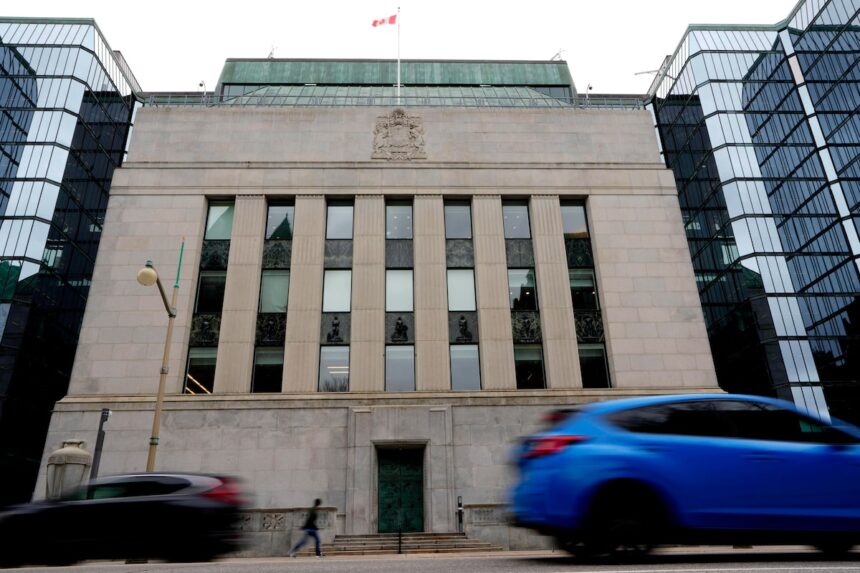The Bank of Canada’s delicate balancing act continued last month as policymakers navigated persistent inflation concerns against growing risks of economic contraction. Minutes from the June rate decision, released yesterday, reveal a Governing Council increasingly concerned about escalating global trade tensions and their potential impact on Canada’s export-dependent economy.
“The specter of protectionism looms larger with each passing month,” said Bank of Canada Governor Tiff Macklem during the press conference following the decision to hold the benchmark rate at 5%. “We’re watching these developments with heightened vigilance as they could fundamentally alter our economic trajectory.”
The newly published summary of deliberations shows council members specifically cited the risk of U.S. tariffs on Canadian goods as a significant downside risk to their economic outlook. With the United States accounting for approximately 75% of Canada’s exports, any disruption to this trading relationship creates outsized vulnerability for Canadian businesses and workers.
The rate decision came amid conflicting economic signals. While inflation moderated to 2.9% in May – approaching the Bank’s 2% target – core measures remained sticky, suggesting underlying price pressures persist. Meanwhile, GDP growth slowed to just 1.7% in the first quarter, considerably below the Bank’s earlier projections.
Deputy Governor Sharon Kozicki emphasized the difficult position facing monetary policymakers. “We’re seeing economic momentum slow more rapidly than anticipated, yet inflation remains stubbornly above target. Each rate decision requires weighing these competing concerns.”
The summary also highlighted divisions within the Governing Council regarding the timing of potential rate cuts. Some members advocated maintaining higher rates longer to ensure inflation’s return to target, while others expressed concern about overtightening amid signs of economic fragility.
“Consumer spending has weakened notably,” the summary noted. “Housing activity remains subdued, and business investment has failed to materialize at expected levels.”
Financial markets responded immediately to the minutes’ release, with the Canadian dollar declining 0.4% against its U.S. counterpart as traders priced in a greater likelihood of rate cuts beginning in September. Bond yields also fell across the curve, reflecting shifting expectations for monetary policy.
Business leaders across Canada are carefully monitoring these developments. At Vancouver-based Westport Manufacturing, CEO Maria Chen reports postponing expansion plans amid uncertainty. “We’ve put $2.7 million in capital investments on hold until we have greater clarity on both interest rates and trade policy,” Chen told CO24 Business.
The Bank’s attention to trade risks comes as Canada-U.S. relations face growing strain. Earlier this month, U.S. officials floated potential aluminum tariffs, while agricultural disputes over dairy and softwood lumber remain unresolved. Any new tariffs would likely trigger retaliatory measures, potentially spiraling into a broader trade conflict.
Economists at major financial institutions have revised their forecasts in response to these developments. TD Bank now predicts two quarter-point rate cuts by year-end, with RBC projecting similar easing but starting later in Q4.
“The Bank is walking a tightrope,” said Avery Williams, chief economist at National Bank. “Cut too soon, and inflation could reignite. Wait too long, and they risk unnecessary economic pain.”
For everyday Canadians, the implications are significant. Mortgage renewal rates remain elevated, straining household budgets, while businesses delay hiring amid uncertainty. Yet consumers have shown remarkable resilience, with retail sales declining less than expected in recent months.
The CO24 Breaking News team will continue monitoring developments as we approach the Bank’s next rate decision on July 24, when updated economic projections will provide further insight into Canada’s monetary policy direction and how global trade tensions might reshape our economic landscape.
Will the Bank of Canada prioritize inflation control, or will mounting evidence of economic weakness and trade risks prompt earlier action? The answer may determine Canada’s economic trajectory for months to come.














